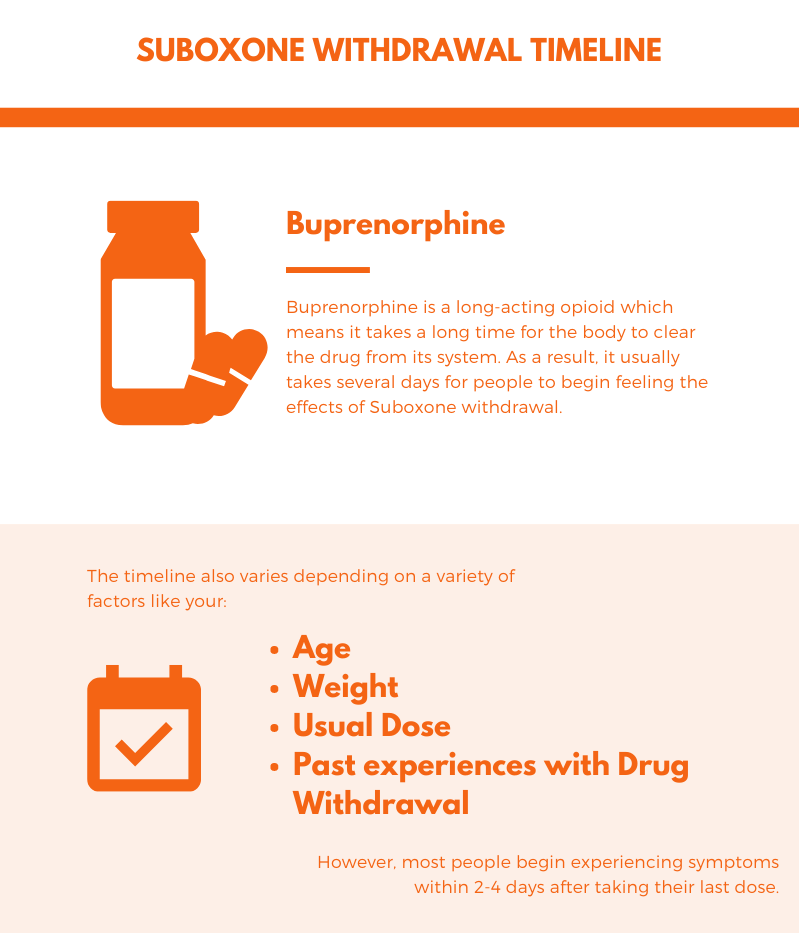Suboxone is a medication that helps treat opioid use disorder by preventing opioid withdrawal and reducing drug cravings. Although the medication is extremely useful in the treatment of opioid addiction, people may experience Suboxone withdrawal when they stop taking the drug. Despite being such an effective medicine, Suboxone contains buprenorphine – a partial opioid agonist that can be addictive when taken for extended periods of time. As a result, Suboxone produces withdrawal symptoms similar to those of other opioids for up to a month after a person stops taking it.
Most people who are in recovery take Suboxone on a short-term basis. Ultimately, the goal of medication-assisted treatment (MAT) is to work towards a taper and place the patient on the path towards total abstinence. However, when a person takes Suboxone for a long time or abuses the drug, physical dependence is likely to develop. Instead of abruptly stopping Suboxone, people should always do so under the instruction of a trusted healthcare provider. Generally, physicians will slowly taper their patients off of the drug by decreasing the dose over a period of time.
Suboxone Withdrawal Timeline

Suboxone withdrawal symptoms are usually at their worst between days three and five where users experience peak withdrawals. Then, the majority of severe symptoms usually subside after one week, however, many psychological symptoms may remain for several weeks and up to a month. For example, by stopping Suboxone use, people may experience the return of anxiety or depression that were muted through medication use. For this reason, it isn’t always easy to quit taking Suboxone without professional guidance. People should always have a plan and a support system in place before stopping Suboxone.
Symptoms of Suboxone Withdrawal
If you have been using Suboxone for a long period of time, you may experience withdrawal symptoms if you skip a dose or decide to quit cold-turkey. The symptoms of Suboxone withdrawal are similar to those of opioid withdrawal but are typically less severe. However, they are still unpleasant and may last for up to a week if a person stops using Suboxone without a taper. These withdrawal symptoms include:[1]
- Pains and muscle aches
- Chills
- Sweating
- Nausea and vomiting
- Diarrhea
- Insomnia
- Stomach cramps
- Restlessness and anxiety
- Runny nose
- Overactive tear ducts
- Goosebumps
- Anxiety
- Depression
- Irritability
If you are working closely under a trusted physician, going through these withdrawal symptoms isn’t something you have to worry about. Most people will undergo tapering to help them manage their symptoms. (Alprazolam)
Fortunately, although withdrawal is unpleasant, it is rarely dangerous. In fact, the biggest threat to people who are detoxing from Suboxone is that they will feel triggered to relapse.[2] Naloxone, the other drug in Suboxone, suppresses drug cravings which may return after a person stops the medication. For this reason, it is crucial to stay connected with your support group and participate in therapies that will help you stay sober and prevent relapse after stopping Suboxone. Obtaining therapy while participating in Suboxone treatment is the key to a successful treatment plan.
Tapering and Symptom Management
Overall, the best way to manage Suboxone withdrawal is to avoid experiencing it in the first place. When taken as prescribed, the drug is a safe and extremely useful medication. However, taking it as prescribed means working closely with an experienced physician. When your physician thinks you are ready to stop taking Suboxone, he or she may prescribe you with a taper to slowly decrease your dose over time. As a general rule of thumb, most Suboxone tapers last between 7-28 days depending on your symptoms, regular dose, and how long you have been taking the medication.
If you are still struggling to manage your withdrawal symptoms, your doctor or addiction counselor may suggest the following to support you:
- Eat a well-balanced diet and stay hydrated
- Practice relaxation techniques for anxiety or irritation
- Find something to keep busy such as a hobby, book, or activity
- Go to extra 12-step meetings or seek support from other local community groups
- Talk with your therapist and doctor about your symptoms
Before you stop taking Suboxone, you should work closely with your support group and/or therapist to develop a long-term treatment plan that focuses on relapse prevention. Suboxone treatment is great for addressing the physical symptoms of opioid addiction, but therapy plays a huge role in helping people maintain long term sobriety.
Get Help Today
Even though Suboxone can help people get sober from opioids, it doesn’t come without potential risks. At PAX Memphis Recovery Center, our experienced doctors will work with you or your loved one every step of the treatment process to help you manage your medication, create a tapering schedule that will prevent Suboxone withdrawal, and support you after getting off your medication.
Attempting to detox from Suboxone on your own is a risky thing to do because it may lead to relapse. Instead of going at it alone, give us a call today to see how we can help.
References:
Medically Reviewed: September 25, 2019

All of the information on this page has been reviewed and verified by a certified addiction professional.










